Radionuclide (RN) interaction with cementitious materials and its hyperalkaline environment must be studied for a correct prediction of radionuclide migration in the long term. One of the important points to predict RN migration is to know their solubility and speciation. Solubility of RN and their interactions with organic compounds present in the repositories are reported in Nuclear Energy Agency (NEA) reports like its chemical thermodynamics volume 9, which was published in 2005 [1]. In particular, studies related to Ni-citrate systems in alkaline and hyperalkaline systems are quite limited. Also, some inconsistencies related with the values facilitated are discussed. Similarly, the mechanistic understanding of the uptake of An(III) by
cementitious materials in the presence of organic ligands is very limited, particularly due to the low concentrations in the aqueous phase and thus the limitations with regard to the use of spectroscopic methods. In this context, the research stay of Oscar Almendros at KIT-INE focused on two objectives using different experimental techniques: (i) the study of Portlandite-Cm(III)-CA/ISA systems with TRLFS, and (ii) the solubility of the binary system Ni-citrate. The latter is expected to provide a sound understanding of the aqueous speciation in the presence of this organic ligands, which is considered as a key input for the for the interpretation and modelling of the ternary system with cement phases. TRLFS measurements allowed the identification of both aqueous complexes and sorbed species in the system Portlandite-Cm(III)-CA/ISA, as well as their corresponding evolution with increasing ligand concentrations. In combination with the wet-chemistry data obtained at CIEMAT for analogous system, these results will contribute to unravel the complex mechanisms driving the retention of An(III) under these conditions. Solubility studies have allowed to gain a sound understanding of complexation phenomena for the Ni(II)-CIT system, both in the absence and presence of Ca. In contrast to initial expectations, Ca does not outcompete Ni(II) for CIT complexation, but instead participates in the formation of ternary complexes of the type Ca-Ni(II)-CIT. Thermodynamic models are currently being derived, and these will be a key input for the the modelling of sorption data obtained in the wet-chemistry experiments at CIEMAT.
Role of organics in radionuclide retention on cement materials
Start date:01/09/2022
End date: 28/02/2023
Beneficiary: Oscar ALMENDROS
Location: KIT-INE
EURAD Work Packages involved
WP3 - CORI


